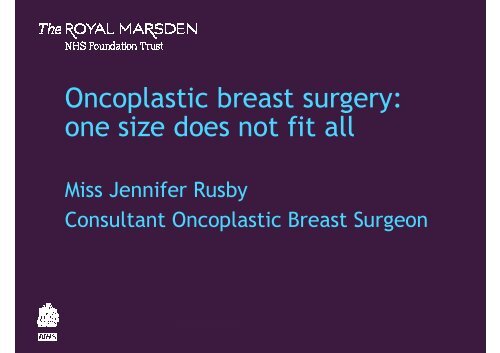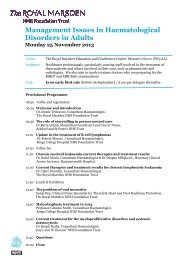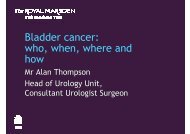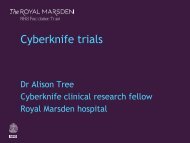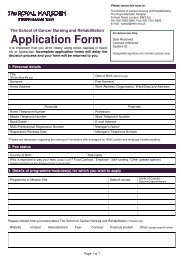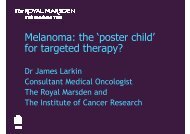Oncoplastic breast surgery - The Royal Marsden
Oncoplastic breast surgery - The Royal Marsden
Oncoplastic breast surgery - The Royal Marsden
Create successful ePaper yourself
Turn your PDF publications into a flip-book with our unique Google optimized e-Paper software.
<strong>The</strong> <strong>Royal</strong> <strong>Marsden</strong><br />
<strong>Oncoplastic</strong> <strong>breast</strong> <strong>surgery</strong>:<br />
one size does not fit all<br />
Miss Jennifer Rusby<br />
Consultant <strong>Oncoplastic</strong> Breast Surgeon<br />
<strong>Oncoplastic</strong> <strong>breast</strong> <strong>surgery</strong> 1
2<br />
<strong>The</strong> <strong>Royal</strong> <strong>Marsden</strong><br />
Overview<br />
<strong>Oncoplastic</strong> <strong>breast</strong> <strong>surgery</strong><br />
1. Facts and figures about surgical management of<br />
<strong>breast</strong> cancer (UK and RMH data)<br />
2. Complexity of surgical decision-making<br />
3. What’s new in oncoplastic <strong>breast</strong> <strong>surgery</strong>
3<br />
<strong>The</strong> <strong>Royal</strong> <strong>Marsden</strong><br />
<strong>Oncoplastic</strong> <strong>breast</strong> <strong>surgery</strong><br />
National facts and figures<br />
– UK 48,034 new <strong>breast</strong> cancer diagnoses in 2008<br />
Cancer Research UK data
4<br />
<strong>The</strong> <strong>Royal</strong> <strong>Marsden</strong><br />
<strong>Oncoplastic</strong> <strong>breast</strong> <strong>surgery</strong><br />
RMH facts and figures<br />
Data for Sutton + Chelsea<br />
– 6703 <strong>breast</strong> referrals in 2010<br />
– 98% seen within two weeks<br />
– 658 new <strong>breast</strong> cancer diagnosis<br />
– 11% of new patient referrals<br />
– majority have <strong>surgery</strong> as first treatment<br />
– 550 referrals for adjuvant treatment eg RT, chemo
5<br />
<strong>The</strong> <strong>Royal</strong> <strong>Marsden</strong><br />
<strong>Oncoplastic</strong> <strong>breast</strong> <strong>surgery</strong><br />
Surgical management of <strong>breast</strong> cancer<br />
Surgery<br />
Breast<br />
Axilla<br />
Breast<br />
conservation<br />
Mastectomy<br />
Sentinel node<br />
biopsy<br />
Axillary<br />
clearance
6<br />
<strong>The</strong> <strong>Royal</strong> <strong>Marsden</strong><br />
<strong>Oncoplastic</strong> <strong>breast</strong> <strong>surgery</strong><br />
Surgical management of <strong>breast</strong> cancer<br />
Surgery<br />
Breast<br />
Axilla<br />
Breast<br />
conservation<br />
Mastectomy<br />
Sentinel node<br />
biopsy<br />
Axillary<br />
clearance<br />
Tumour : <strong>breast</strong><br />
volume ratio<br />
Neoadjuvant<br />
therapy<br />
<strong>Oncoplastic</strong><br />
techniques<br />
No reconstruction<br />
Reconstruction<br />
Implant-only<br />
Latissimus dorsi<br />
Patient<br />
preferences<br />
Adjuvant<br />
therapies<br />
Co-morbidities<br />
Free flap
7<br />
<strong>The</strong> <strong>Royal</strong> <strong>Marsden</strong><br />
<strong>Oncoplastic</strong> <strong>breast</strong> <strong>surgery</strong><br />
Mastectomy rate<br />
Second Breast Cancer Report 2011
8<br />
<strong>The</strong> <strong>Royal</strong> <strong>Marsden</strong><br />
<strong>Oncoplastic</strong> <strong>breast</strong> <strong>surgery</strong><br />
RMH mastectomy rate<br />
100%<br />
90%<br />
80%<br />
70%<br />
60%<br />
50%<br />
40%<br />
<strong>Oncoplastic</strong> procedure<br />
Wide local excision<br />
<strong>The</strong>rapeutic mastectomy<br />
30%<br />
20%<br />
10%<br />
0%<br />
Sept-Oct Nov-Dec Jan-Feb Mar-Apr May-Jun Jul-Aug Sept-Oct Nov-Dec<br />
<strong>The</strong>rapeutic mastectomy rate 41%
9<br />
<strong>The</strong> <strong>Royal</strong> <strong>Marsden</strong><br />
<strong>Oncoplastic</strong> <strong>breast</strong> <strong>surgery</strong><br />
Strategies to reduce mastectomy rate<br />
– Earlier diagnosis<br />
– Neoadjuvant endocrine or chemotherapy<br />
– <strong>Oncoplastic</strong> <strong>breast</strong> conserving <strong>surgery</strong>
10<br />
<strong>The</strong> <strong>Royal</strong> <strong>Marsden</strong><br />
<strong>Oncoplastic</strong> <strong>breast</strong> <strong>surgery</strong><br />
Screen-detected <strong>breast</strong> cancer has lower<br />
mastectomy rate<br />
100<br />
80<br />
60<br />
Screendetected<br />
40<br />
Symptomatic<br />
20<br />
0<br />
11 <strong>The</strong> <strong>Royal</strong> <strong>Marsden</strong> <strong>Oncoplastic</strong> <strong>breast</strong> <strong>surgery</strong><br />
Only 30% of <strong>breast</strong> cancers are screen-detected<br />
Second Breast Cancer Report 2011
12<br />
<strong>The</strong> <strong>Royal</strong> <strong>Marsden</strong><br />
<strong>Oncoplastic</strong> <strong>breast</strong> <strong>surgery</strong><br />
Strategies to reduce mastectomy rate<br />
– Earlier diagnosis<br />
– Neoadjuvant endocrine or chemotherapy<br />
– 16% of our patients have chemotherapy as first<br />
treatment<br />
– <strong>Oncoplastic</strong> <strong>breast</strong> conserving <strong>surgery</strong>
13<br />
<strong>The</strong> <strong>Royal</strong> <strong>Marsden</strong><br />
<strong>Oncoplastic</strong> <strong>breast</strong> <strong>surgery</strong><br />
Strategies to reduce mastectomy rate<br />
– Earlier diagnosis<br />
– Neoadjuvant endocrine or chemotherapy<br />
– 16% of our patients have chemotherapy as first<br />
treatment<br />
– <strong>Oncoplastic</strong> <strong>breast</strong> conserving <strong>surgery</strong><br />
– <strong>The</strong>rapeutic mammoplasty (<strong>breast</strong> reduction)<br />
– Grisotti operation for central <strong>breast</strong> tumours
14<br />
<strong>The</strong> <strong>Royal</strong> <strong>Marsden</strong><br />
<strong>Oncoplastic</strong> <strong>breast</strong> <strong>surgery</strong><br />
Case 1: 48 year old<br />
Presented with lump in right upper outer<br />
quadrant<br />
–Mammogram M5: extensive calcifications (100mm)<br />
–Ultrasound U5: large ill-defined low echogenicity area<br />
–Core biopsy: grade 3 IDC, ER-, PR-, Her2 3+
15<br />
<strong>The</strong> <strong>Royal</strong> <strong>Marsden</strong><br />
<strong>Oncoplastic</strong> <strong>breast</strong> <strong>surgery</strong><br />
Case 1: 48 year old<br />
Treatment options for this lady include:<br />
– mastectomy, chemotherapy, radiotherapy<br />
– chemotherapy, <strong>breast</strong> conservation, radiotherapy<br />
– <strong>breast</strong> conservation, chemotherapy, radiotherapy
16<br />
<strong>The</strong> <strong>Royal</strong> <strong>Marsden</strong><br />
<strong>Oncoplastic</strong> <strong>breast</strong> <strong>surgery</strong><br />
Immediate reconstruction rate<br />
What is the UK national immediate <strong>breast</strong><br />
reconstruction rate<br />
1. 70%
17<br />
<strong>The</strong> <strong>Royal</strong> <strong>Marsden</strong><br />
<strong>Oncoplastic</strong> <strong>breast</strong> <strong>surgery</strong><br />
Immediate reconstruction rate<br />
What is the UK national immediate <strong>breast</strong><br />
reconstruction rate<br />
1. 70%<br />
Second annual report of National Mastectomy<br />
and Breast Reconstruction Audit 2009
18<br />
<strong>The</strong> <strong>Royal</strong> <strong>Marsden</strong><br />
<strong>Oncoplastic</strong> <strong>breast</strong> <strong>surgery</strong><br />
RMH immediate <strong>breast</strong> reconstruction rate<br />
0.6<br />
0.5<br />
0.4<br />
0.3<br />
0.2<br />
0.1<br />
0<br />
May-<br />
Jun<br />
09<br />
Jul-<br />
Aug<br />
Sept-<br />
Oct<br />
Nov-<br />
Dec<br />
Jan-<br />
Feb<br />
10<br />
Mar-<br />
Apr<br />
May-<br />
Jun<br />
Jul-<br />
Aug<br />
Sept-<br />
Oct<br />
Nov-<br />
Dec<br />
TE LD TRAM DIEP Immediate reconstruction<br />
Immediate reconstruction rate after therapeutic mastectomy is 38%
19<br />
<strong>The</strong> <strong>Royal</strong> <strong>Marsden</strong><br />
<strong>Oncoplastic</strong> <strong>breast</strong> <strong>surgery</strong><br />
Immediate reconstruction rate
20<br />
<strong>The</strong> <strong>Royal</strong> <strong>Marsden</strong><br />
<strong>Oncoplastic</strong> <strong>breast</strong> <strong>surgery</strong><br />
Case 2: 50 year old<br />
Presented with screen-detected multifocal left<br />
<strong>breast</strong> cancer<br />
–Mammogram M3 / M5: 12 and 9 o’clock<br />
–Ultrasound U5 / U5: 12 and 9 o’clock (15 and 16mm)<br />
–Core biopsy: grade 2 IDC<br />
–Axilla normal on USS<br />
–Family history<br />
– grandmother <strong>breast</strong> cancer 60's<br />
– mother ovarian cancer late 20's<br />
– aunt bone mets of unknown primary late 30's
21<br />
<strong>The</strong> <strong>Royal</strong> <strong>Marsden</strong><br />
<strong>Oncoplastic</strong> <strong>breast</strong> <strong>surgery</strong><br />
Case 2 50 year old<br />
Appropriate management for this lady:<br />
– Breast conservation or mastectomy<br />
– Unilateral or bilateral mastectomy<br />
– Immediate reconstruction or not
22<br />
<strong>The</strong> <strong>Royal</strong> <strong>Marsden</strong><br />
<strong>Oncoplastic</strong> <strong>breast</strong> <strong>surgery</strong><br />
Case 2: 50 year old<br />
Surgical history:<br />
– Staging sentinel lymph node biopsy<br />
– 0/2<br />
– Bilateral skin-sparing mastectomy and immediate<br />
DIEP flap reconstruction (Kelvin Ramsey)<br />
– Nipple reconstruction and excision of abdominal “dog<br />
ears”
23<br />
<strong>The</strong> <strong>Royal</strong> <strong>Marsden</strong><br />
<strong>Oncoplastic</strong> <strong>breast</strong> <strong>surgery</strong><br />
What’s new in oncoplastic <strong>breast</strong> <strong>surgery</strong><br />
Nipple preservation in carefully selected<br />
patients<br />
<strong>Oncoplastic</strong> MDT working<br />
23h stay for mastectomy and / or axillary clearance<br />
OSNA<br />
Open access follow up<br />
Lymphatico-venous anastomosis for lymphoedema
24<br />
<strong>The</strong> <strong>Royal</strong> <strong>Marsden</strong><br />
<strong>Oncoplastic</strong> <strong>breast</strong> <strong>surgery</strong><br />
Case 3: 31 year old<br />
Strong family history, BRCA negative family<br />
mother bilateral at 48 – tested BRCA negative<br />
maternal grandmother 48<br />
two maternal aunts (one bilateral)<br />
Reviewed by geneticists<br />
Reviewed by psychologists<br />
Discussions with <strong>breast</strong> care nurses<br />
Opportunity to see photographs<br />
Decision to proceed with bilateral risk-reducing mastectomy ad<br />
immediate implant only reconstruction with nipple preservation
25<br />
<strong>The</strong> <strong>Royal</strong> <strong>Marsden</strong><br />
<strong>Oncoplastic</strong> <strong>breast</strong> <strong>surgery</strong><br />
What’s new in oncoplastic <strong>breast</strong> <strong>surgery</strong><br />
<strong>Oncoplastic</strong> multidisciplinary working<br />
Joint and parallel clinics with <strong>breast</strong> and plastic surgeons<br />
<strong>Oncoplastic</strong> multidisciplinary meeting (fortnightly)<br />
Rusby et al Annals of <strong>Royal</strong> College of Surgeons 2011
26<br />
<strong>The</strong> <strong>Royal</strong> <strong>Marsden</strong><br />
<strong>Oncoplastic</strong> <strong>breast</strong> <strong>surgery</strong><br />
What’s new in oncoplastic <strong>breast</strong> <strong>surgery</strong><br />
23h stay for mastectomy and / or axillary clearance
27<br />
<strong>The</strong> <strong>Royal</strong> <strong>Marsden</strong><br />
<strong>Oncoplastic</strong> <strong>breast</strong> <strong>surgery</strong><br />
What’s new in oncoplastic <strong>breast</strong> <strong>surgery</strong><br />
23h stay for mastectomy and / or axillary clearance<br />
Clearer pathways around admission and discharge<br />
Managing patient expectation<br />
No drains!
28<br />
<strong>The</strong> <strong>Royal</strong> <strong>Marsden</strong><br />
<strong>Oncoplastic</strong> <strong>breast</strong> <strong>surgery</strong><br />
What’s new in oncoplastic <strong>breast</strong> <strong>surgery</strong><br />
23h stay for mastectomy and / or axillary<br />
clearance<br />
Statistical reduction in length of stay<br />
No statistical difference in rate of complications (ongoing study)<br />
Wong et al Poster at Association of Breast Surgeons meeting 2011
29<br />
<strong>The</strong> <strong>Royal</strong> <strong>Marsden</strong><br />
<strong>Oncoplastic</strong> <strong>breast</strong> <strong>surgery</strong><br />
What’s new in oncoplastic <strong>breast</strong> <strong>surgery</strong><br />
OSNA (one-step nucleic acid amplification) for<br />
intra-operative testing of sentinel lymph nodes<br />
Sentinel lymph node biopsy reduces morbidity of<br />
axillary <strong>surgery</strong><br />
If sentinel node negative, no further axillary <strong>surgery</strong><br />
If sentinel node positive (macrometastasis), then<br />
proceed to completion axillary lymph node dissection<br />
Second procedure or intraoperative assessment<br />
Touch-imprint cytology or molecular techniques
30<br />
<strong>The</strong> <strong>Royal</strong> <strong>Marsden</strong><br />
<strong>Oncoplastic</strong> <strong>breast</strong> <strong>surgery</strong><br />
What’s new in oncoplastic <strong>breast</strong> <strong>surgery</strong><br />
OSNA (one-step nucleic acid amplification)<br />
Real-time polymerase chain reaction (RT-PCR)<br />
Pathologist not required<br />
Highly sensitive…..too sensitive<br />
Aim to avoid second operation
31<br />
<strong>The</strong> <strong>Royal</strong> <strong>Marsden</strong><br />
<strong>Oncoplastic</strong> <strong>breast</strong> <strong>surgery</strong><br />
What’s new in oncoplastic <strong>breast</strong> <strong>surgery</strong><br />
Open access follow-up<br />
Beth Jackson to speak on this later
32<br />
<strong>The</strong> <strong>Royal</strong> <strong>Marsden</strong><br />
<strong>Oncoplastic</strong> <strong>breast</strong> <strong>surgery</strong><br />
What’s new in oncoplastic <strong>breast</strong> <strong>surgery</strong><br />
Lymphatico-venous anastomosis for lymphoedema<br />
Kelvin Ramsey<br />
220 ALNC at RMH in 2010<br />
Incidence of lymphoedema approximately 25%<br />
Previously, treatment for lymphoedema has aimed to control<br />
symptoms: physio, massage, compression<br />
Developments in fluorescence lymphography enable surgeon to<br />
identify functional lymphatics<br />
Developments in super-micro<strong>surgery</strong> enable surgeon to perform<br />
lymphatico-venous anastomosis of vessels
33<br />
<strong>The</strong> <strong>Royal</strong> <strong>Marsden</strong><br />
<strong>Oncoplastic</strong> <strong>breast</strong> <strong>surgery</strong><br />
References<br />
Second all <strong>breast</strong> cancer report (2011):<br />
http://www.ncin.org.uk/publications/reports/default.aspx<br />
Second annual report of NMBRA (2009):<br />
http://www.ic.nhs.uk/mbr
34<br />
<strong>The</strong> <strong>Royal</strong> <strong>Marsden</strong><br />
<strong>Oncoplastic</strong> <strong>breast</strong> <strong>surgery</strong>


